Other Storey Titles You Will Enjoy
The Dog Behavior Answer Book, by Arden Moore.
Answers to your questions about canine quirks,
baffling habits, and destructive behavior.
336 pages. Paper. ISBN 978-1-58017-644-6.
Dr. Kidds Guide to Herbal Dog Care,
by Randy Kidd, DVM, PhD.
A comprehensive guide to gentle, chemical-free
treatments for your beloved canine.
208 pages. Paper. ISBN 978-1-58017-189-2.
Happy Dog, Happy You, by Arden Moore.
Gentle humor and inspired advice from a pet
expert to owners and their canine friends.
304 pages. Paper. ISBN 978-1-60342-032-7.
The Puppy Owners Manual, by Diana Delmar.
How to solve all your puppy problems
and create a puppy-friendly home.
192 pages. Paper. ISBN 978-1-58017-401-5.
Real Food for Dogs, by Arden Moore.
A collection of 50 vet-approved recipes
to please your canine gastronome.
128 pages. Paper. ISBN 978-1-58017-424-4.
These and other books from Storey Publishing are available
wherever quality books are sold or by calling 1-800-441-5700.
Visit us at www.storey.com .
 MORE COUNTRY WISDOM BULLETINS YOU WILL ENJOY!
MORE COUNTRY WISDOM BULLETINS YOU WILL ENJOY!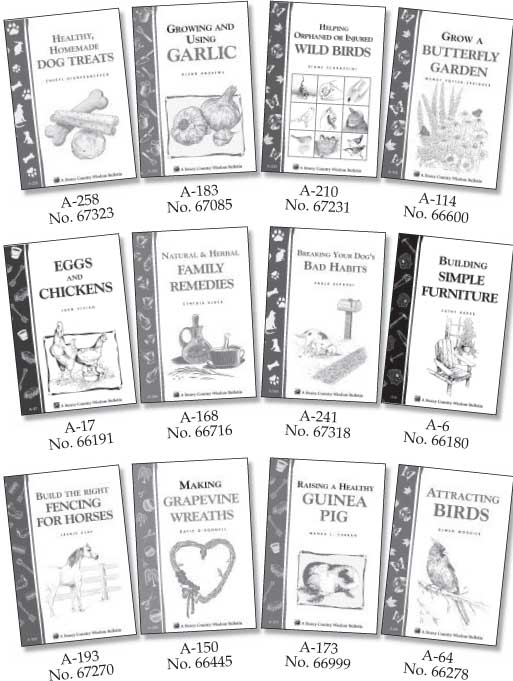
These and other Storey Country Wisdom Bulletins are available for $3.95 at your local bookstores, garden centers, farm stores, and gift shops. Use the order numbers listed under each bulletin to make your requests. You can also order directly from Storey Publishing by writing to us at 210 MASS MoCA Way, North Adams, MA 01247 or by calling 1-800-441-5700. For more information about our books and bulletins, visit our Web site at www.storey.com .
The Basic Nature of a Dog: Leader or Follower?
Dogs are pack animals and by nature need to live in a group situation. A dogs position in the pack can be at only one of two levels: the leader or a follower. Except for very rare individuals, dogs really dont care if theyre the top dog or not, but they do need to know what their position is at all times. It doesnt take a puppy very long to accept its new human family as its pack. The real question is, will he be a leader or a follower?
If a dog isnt sure whether hes the leader or a follower, he will try to be the leader until you show him differently. Being the leader is a hard job for a dog. If you show him that you are in the number one position, your dog will easily accept being a follower. With that he gets the security of belonging to your pack.
Your Role as Leader
You must be the leader, but you cannot lead with cruelty. You must be firm but fair, understanding and respecting your dogs natural instincts. You must not permit misbehavior, but you also must never be abusive. A dog that is full of fear is unstable and unpredictable and therefore not a good companion.
It will be your goal to direct your dog so that she understands and learns what is acceptable behavior. She can do this only if your training is clear, consistent, and properly timed.
Remember that you should never get angry at your dog, yell, repeat a command over and over, or hit or handle her roughly. You will gain nothing except your dogs mistrust.

A Dogs Senses
In order to do a good job of training your dog, its important for you to understand how a dog experiences his world and what makes a dog tick. A dog has the same senses as a human, but they are different in several ways.
Your Dogs Instincts
An instinct is a behavior pattern that is inherited and not learned. An example is suckling. All mammals are born with the instinct to nurse. They dont have to be taught to do it. Dogs including your puppy or dog have inherited strong instincts from their wild ancestors. You may see your dog exhibiting any of the following common instincts.
 Guarding: Your dog may guard your yard, your home, or a favorite toy.
Guarding: Your dog may guard your yard, your home, or a favorite toy.
 Pack instinct: This is the instinct to group together. If your dog is with several other dogs, he will have the instinct to behave as if hes a member of a pack.
Pack instinct: This is the instinct to group together. If your dog is with several other dogs, he will have the instinct to behave as if hes a member of a pack.
 Prey drive: Prey drive is the instinct to chase a moving object. In the wild, dogs displayed this instinct when they hunted. Herding, driving, and chasing are all parts of prey drive.
Prey drive: Prey drive is the instinct to chase a moving object. In the wild, dogs displayed this instinct when they hunted. Herding, driving, and chasing are all parts of prey drive.
 Digging, barking, and marking: These are all natural behaviors of dogs and are familiar to most dog owners.
Digging, barking, and marking: These are all natural behaviors of dogs and are familiar to most dog owners.
Smell
Your dog lives in a world rich with a multitude of scents that we cannot even imagine. The part of her brain that receives messages about scents is over 1,000 times larger than ours. Not only can a dog tell the difference among hundreds and hundreds of smells, but she can also remember them. In addition, a dogs sense of smell is so finely tuned that shes able to notice a very small amount of a particular odor, even if there are many other odors present. For example, your dog is able to pick out your scent on the one object youve touched from all of the others in a pile of identical objects.
Hearing
The dog can hear all of the frequencies that a human can hear and well beyond. As you will have noticed if youve ever owned a dog before, dogs are able to move their ears in the direction of the sounds they hear. They tune in to different things in sound than humans do.
Sight
The dogs sense of sight is sharp when it comes to viewing familiar shapes and moving objects. His ability to distinguish fine details is not as well developed as that of humans, though. A dog is not good at picking out differences in movement or shape, for example. Ive tried walking past dogs that knew me with a limping gait or my hair in a much different style, and they have always acted as if they didnt recognize me until I spoke or they could catch my scent.
Earning Your Puppys Respect, Trust, and Confidence
Your dog needs a leader, and thats you. A puppy must learn self-control and self-discipline. He will learn this as you help him to be obedient. The puppy needs lots of affection, but you must not let him have his way when what hes doing isnt right. He will learn to follow your guidance because he wants to be obedient. You teach your puppy obedience by repeating the same thing over and over and giving praise when he gets it right.
Be Consistent and Firm
Decide what behaviors you will allow and what you wont allow from your puppy. The best way to correct a problem behavior is to prevent it in the first place. Dont put your puppy on your lap while youre on the couch if you dont want him to get on the couch as an adult. Never give the puppy a command that you cant or dont enforce. An example is telling a dog Down when he jumps on you. Are you going to squat down and put the dog in a down position? Does your dog know the word


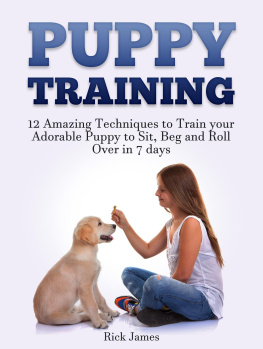


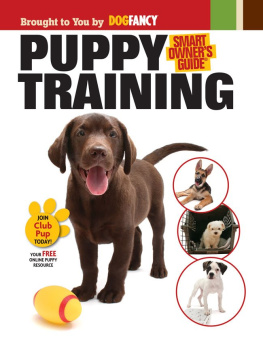



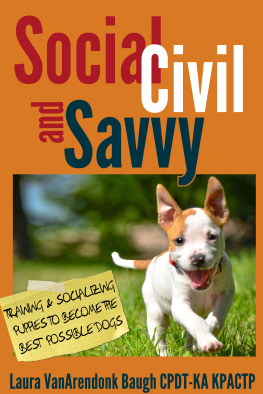
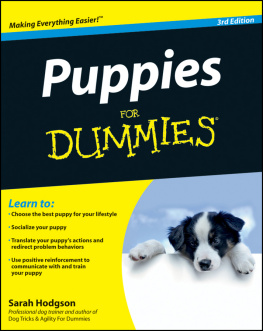
 MORE COUNTRY WISDOM BULLETINS YOU WILL ENJOY!
MORE COUNTRY WISDOM BULLETINS YOU WILL ENJOY!

 Guarding: Your dog may guard your yard, your home, or a favorite toy.
Guarding: Your dog may guard your yard, your home, or a favorite toy.